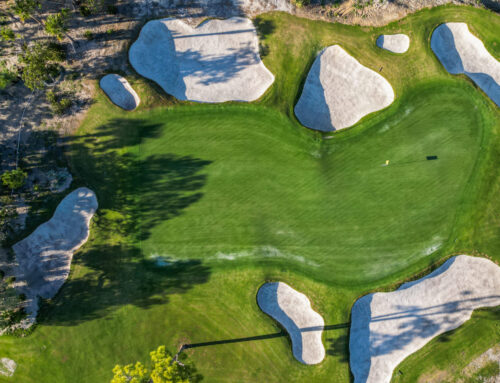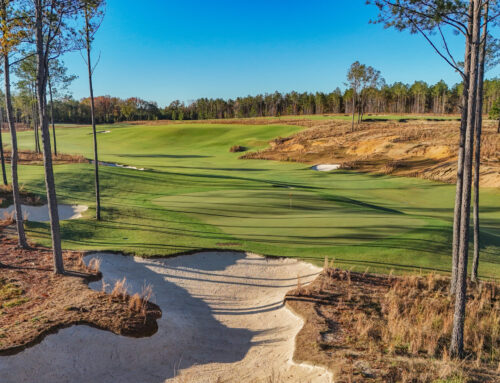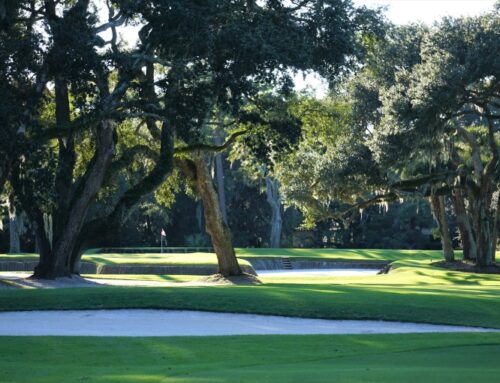Canterbury Golf Club
OH, USA
Green Keeper: Terry Bonar
Most golf course architects, like most artists of any form, are incapable of greatness. Be it a lack of ability or a lack of opportunity or both, their work never achieves an originality that is praiseworthy and that advances their art form. Such is patently not the case with Englishman Herbert Strong.
Though he worked with a range of sites from Florida to Canada, he was never given a raw site with which to work that rivaled some of his peers. For instance, Donald Ross had the sandy soil and duneline at Seminole, Seth Raynor had Fishers Island, Alister Mackenzie had Cypress Point, Harry Colt had Portrush, etc.
Yet, from very good but never quite great sites, Herbert Strong had the uncanny ability to build courses that were considered world class. Tom MacWood’s 1939 course ranking includes three Herbert Strong designs in the world top one hundred, namely the Ponte Vedra Club in Florida, Manoir Richelieu in Canada and the Engineers Club on Long Island. Interestingly enough, Herbert Strong’s Inwood on Long Island and Canterbury in the golf rich eastern suburbs of Cleveland did not make the list, though they have hosted the most major competitions of any of Herbert Strong courses.
Born in Ramsgate, England in 1879, Herbert Strong started his career in golf as a club maker. The course six kilometres down the road in Sandwich which Laidlaw Purves laid out in 1887 had a huge influence on the young Herbert Strong. Purves’ original course full of blind shots and deep hazards was even more wild and rugged than the Royal St. George’s course of today. With this heroic links firmly in mind, Herbert Strong arrived in New York and became the golf professional at Apawamis Club. As historian Tom MacWood points out,
Herbert Strong was a very fine golfer and as an architect acquired a reputation for making championship venues, and Canterbury fits right into that mold. It began at Apawamis – Herbert Strong’s first job in the States. It hosted the 1911 US Amateur shortly after Herbert Strong re-designed the course to take better advantage of the site’s pronounced landforms. Following that event, Herbert Strong moved from Apawamis to Inwood, and proceeded to overhaul that course in 1915. Inwood hosted the 1921 PGA and the 1923 US Open. In 1917, he moved to Engineers after being hired to design their new course. Engineers hosted the 1919 PGA, the 1920 US Amateur and the 1924 Metropolitan Open. Herbert Strong designed Lakeview in Toronto in 1920 and it instantly became the championship course of that city. Lakeview hosted the 1923 and 1934 Canadian Open. In 1932, Herbert Strong built the Ponte Vedra Club in Florida, and the 1934 Florida State Amateur and the 1938 Southern Amateur were played over its links. Ponte Vedra was also awarded the 1939 Ryder Cup, unfortunately that event never took place due to the War.
Though little appreciated today, Herbert Strong was without question one of the preeminent golf course architects in 1920. As such, when a group of Cleveland businessmen wished to build a course of the highest calibre in 1921, Herbert Strong was a logical candidate.
No doubt shaped by the boldness of St. George’s in England, Herbert Strong had strong opinions when it came to golf course architecture, and he wasn’t afraid to take chances. In the case of Canterbury Golf Club, the back nine opened several months after the front on the first nine on July 1st, 1922 and featured three par threes and a 660 yard par six. At some point in the late 1920s, the head golf professional Jack Way reconfigured the first four holes on the back converting one of the par threes to a par four and reducing the sixteenth to a par five of 610 yards (at this point, remember too that steel was replacing hickory as the preferred material for golf shafts).
Ever since the back nine at Canterbury Golf Club became more ‘conventional’, all the major golf organizations have beat a path to its door to host their biggest events. The first was the Western Open in 1932 which was won by Walter Hagen at even par. At the time, the Western Golf Association was every bit the equal to the United States Golf Association in terms of prestige. The event proved so popular that they quickly returned in 1937. The first of two United States Opens was contested here in 1940 and the PGA Championship was held here in 1973, won by Ohio’s favorite son, Jack Nicklaus.
However, the passage of time has a way of doing cruel things to parkland courses in particular. Trees grow, fairways narrow, fairway bunkers become detached from the fairways they once bordered, and greens shrink. Also, common for a course of Canterbury‘s age, several other architects were allowed to tinker with the course as the decades past. For example, Geoffrey Cornish added fairway bunkers on the second, fifth, sixth and eighteenth holes. Some of the these bunkers were larger and more shallow and tended to be on the outside of doglegs.
Though clearly a Golden Age course, the Club appreciated that there were several competing design styles within the course. So in 1998, they made the wise decision to approach Renaissance Golf Design and Bruce Hepner, who had a long-standing relationship with Green Keeper Terry Bonar. Over the past decade, Bruce Hepner working closely with Bonar has seen Canterbury Golf Club return to its peak. Select trees have been felled during the winters, opening up long views that show how Herbert Strong went up and over the hills in all sorts of varying manners. Though Herbert Strong only had 138 acres at his disposal, each hole seems to stand alone either in its own valley like the fifth or as it plays up and down hills like at the ninth.
With the playing corridors widened, Bruce Hepner helped oversee the expansion of fairways back to the fairway bunker edges and the greens pushed back out to the corners of their fill pads. Improved sunlight and air flow has seen Canterbury Golf Club’s turf regain its famous keeness. In addition, all the bunkers were edged and random grass capes were pulled down their face to give the bunkers a uniform appearance. Especially pleasing to Bruce Hepner and the Club is that all this was done without huge expense, in stark contrast to some Golden Age courses in Ohio like Scioto and Inverness that have spent millions of dollars on their course only to end up with a diluted product.
Holes To Note
First hole, 445 yards; The golfer sees his tee ball finish in the fairway on less than half of the fourteen non-par three holes at Canterbury Golf Club. Why so, you ask? Because the property here in the eastern suburbs of Cleveland is ideally rolling and Herbert Strong’s routing confronts the undulations in ever manner possible. Here at the first, the fairway disappears over the crest of a hill before swinging right toward the green, which is worthy of great study in and of itself. Its fill pad isn’t nearly as tall or pronounced as what some of Herbert Strong’s contemporary’s like Tillinghast and Raynor were building. The green hugs the ground more yet still features a fearsome amount of back to front tilt. At only twenty-six yards in depth, the green is the shallowest on the front and it is all too easy to putt off its front.
Second hole, 365 yards; Herbert Strong’s fairway captures the crumpled ground before climbing higher to the green. This is the most heavily bunkered hole on the course with eleven but the hole’s real defense is the green’s tilt which falls over three feet from back to front.
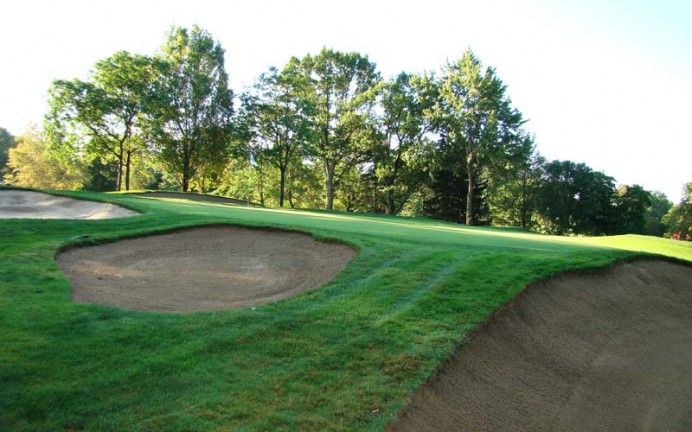
As this photograph captures, the severe back to front tilt puts a premium on staying below the hole.
Third hole, 175 yards; As a sign of how the game has changed, this hole was singled out in a 1921 article as being particularly difficult because it entailed a forced carry over water. The sports writer predicted doom to all that played this hole. The fact that it was 145 yards in 1921 and that the edge of the pond stopped twenty yards from the green didn’t matter; it was still a lost ball for any duffer who topped his tee shot. A recent tree clearing program has helped expose this green more and in doing so, the hole looks less welcoming than before. The general cant of the green from back left to front right causes plenty of problems in this age where Canterbury Golf Club‘s greens are routinely presented at 10.5 on the stimp.

The morning sunlight is telling of the successful tree removal program that Canterbury has slowly undertaken over the past decade. Just three years ago and the green would still be cloaked in the morning shadows, so thick where the trees around the green.
Fourth hole, 490 yards; Canterbury Golf Club now measures over 7,000 yards in part thanks to Bruce Hepner’s pushing this tee forty yards back to the top of a hill. What this did was to fully restore the challenge of the hole to Herbert Strong’s day. The tiger in the early 1920s carried a ball with his hickory golf club in the 240 yard range. Today’s professionals carry the ball some forty-five yards past that; hence the increase in distance from Herbert Strong’s original 415 yard tee to today’s length of 490 preserves the integrity of both the tee ball and approach shot. A tee ball that carries 280 yards hits into the upslope of the fairway by the nest of bunkers and no longer receives a big kick forward. The golfer is left with a semi-blind approach shot of approximately 190 yards, calling for a mashie as in Herbert Strong’s day. This is Bruce Hepner’s favorite hole on the course and how it is not better known/appreciated in world golf is hard to fathom.

Framed by sycamore trees, the fourth green is open in front and shots tend to feed to the back right.
Fifth hole, 410 yards; Herbert Strong wasn’t afforded an enormous canvas with which to work at Canterbury Golf Club. What is startling to Bruce Hepner and other students of golf course architecture is how well his routing takes advantage of every physical attribute of the property while giving each hole a sense of spaciousness. In this case, the fifth plays within a shallow valley where the golfer feels alone on the property. In reality, the fourth and sixth fairways are nearby.
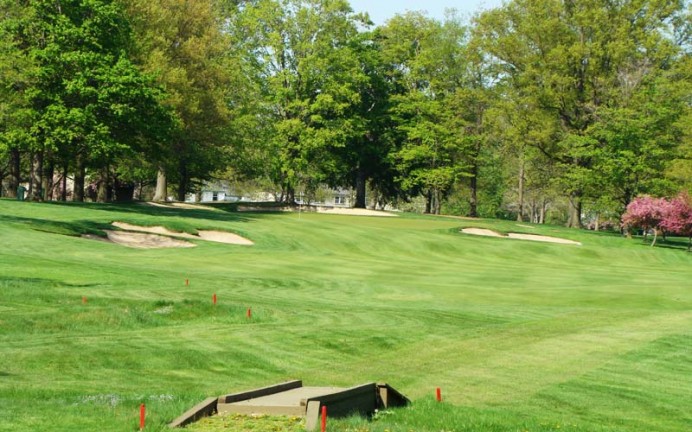
This back tee was added in the late 1980s by Geoffrey Cornish and gives the golfer a better sense of the valley that the fifth plays up. Not only is the hole thirty-five yards longer from this tee, it also plays uphill, leaving the golfer with a similar club into the green as in Strong
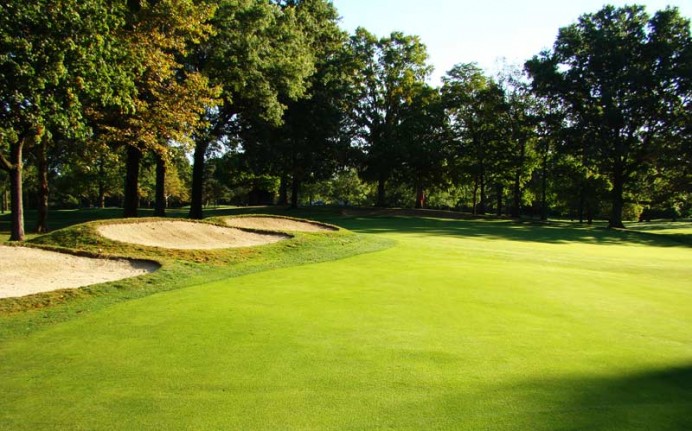
The fifth green complex is one of the best on the course, highlighted by a) the tight turf before the green (the red flag and green are in the shadows ahead), b) this distinctive string of three Strong bunkers along the left and…
Sixth hole, 520 yards; When the Senior PGA Championship comes to Canterbury Golf Club in 2009, they are going to play this and the thirteenth as par four holes. Don’t be surprised to see over par as the winning score as Canterbury Golf Club played as a tight par 70 is a daunting test. At 5,300 square feet, this green can accept a long shot. Played in the 490 to 520 yard range, this is a neat risk/reward half par hole where the good golfer feels compelled to try and make something happen. This hole’s integrity is well defended at the green by Herbert Strong’s greenside bunkers with the out of bounds close on the right giving the bold golfer plenty to think about.
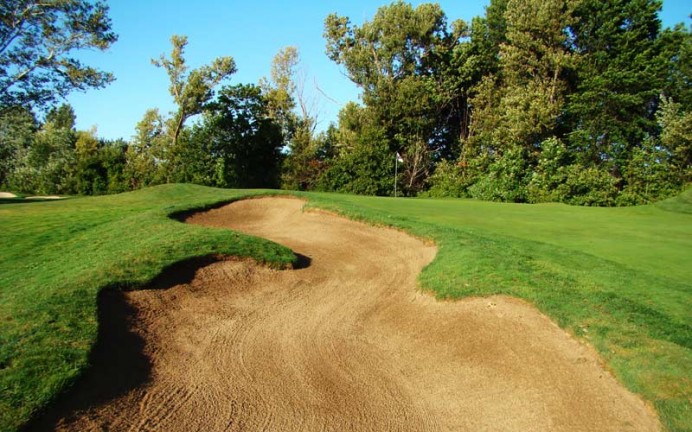
A Strong course always features a wide range of bunker shapes and sizes. Here at the sixth, this singular scar bunker guards the left of the green…
Seventh hole, 200 yards; One reason that Canterbury Golf Club has hosted so many major events is that it has a long tradition of presenting fast and firm playing surfaces. This is not by accident as a Herbert Strong design was always well engineered in so far as his greens and fairways were built to drain quickly and properly. In addition, the importance of Green Keeper’s Terry Bonar presence at Canterbury Golf Club for over forty years (!) cannot be overstated. Jack Nicklaus and others have proclaimed the through the green playing conditions at Canterbury Golf Club to be among the very best they have ever seen world-wide.
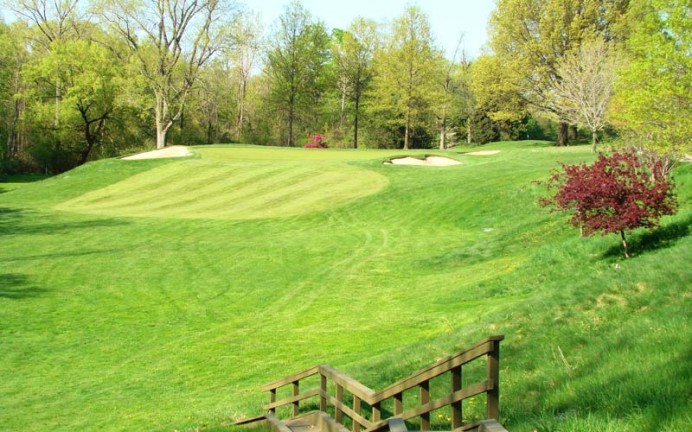
The lowest point at Canterbury is between the tee and green at the 200 yard one shot seventh hole seen above. No surprise that Strong avoided this low lying area by having the seventh play above it.
Eighth hole, 410 yards; A straight drive is an absolute must on this straight hole as out of bounds left crowds within fourteen paces of the fairway. As is always the case with any sub-400 yard hole that Herbert Strong designed (this hole was 360 yards in Herbert Strong’s day), the green complex is noteworthy.
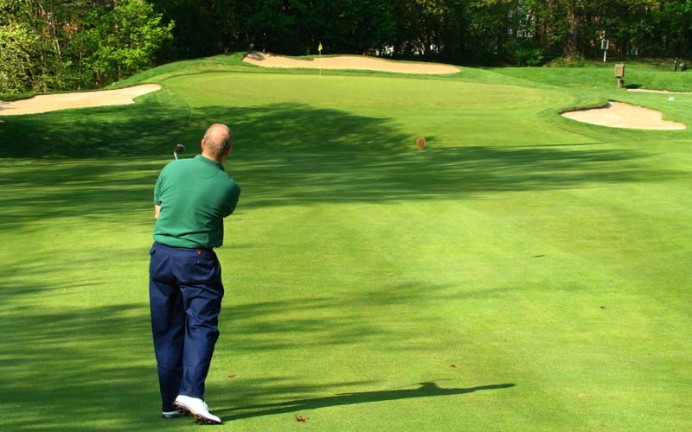
The golfer able to hit well placed drives at Canterbury is rewarded with approach shots into numerous attractive targets such as this one at the eighth.
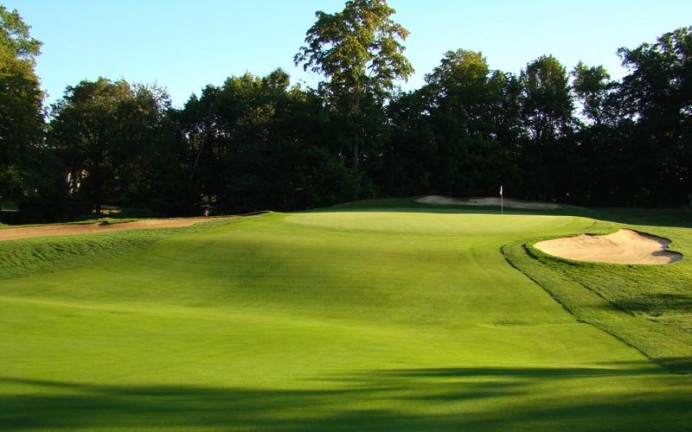
A ball that finishes just on is in jeopardy of rolling off the false front and down into the swale prior to the green. Somewhat unusual for his time, Strong believed in back bunkers to frame the green as a target. Such a back bunker(s) is found here as well as the second, third, fifth, ninth, eleventh, thirteenth, sixteenth and eighteenth greens.
Tenth hole, 360 yards; Strong originally had a par three as the tenth hole and it was located in such a manner that golfers needed to walk through the clubhouse to get to it. In addition, it was the first of three one shotters on the back. Head Golf Professional Way changed it to a downhill par four with a tee only fifty yards left from the ninth green. Hepner has helped make this hole look and play like it belongs on a Strong design. He writes, ‘The quick fix for the tenth hole was very simple. Correct the mowing lines of the green and fairway. Then the most important fix was the trees. There were pines on the right down by the stream that blocked a view of the green even when you were in the right side of the fairway. There also was a group of spruces located on the outside of the dog leg. The spruces gave the golfer a sense of containment that would turn the hole, so golfers would comfortably blast their drivers right into them and be in their pocket. We removed all the pines and freed up the design so that golfers could think about their tee shot. If executed, they would be rewarded with an open look at the green. Because of the open look through the turn of the hole, many golfers now just cut a nice 3 wood down to the bottom of the hill. They now have a chance to think. The hole isn’t spectacular, it is just good golf.’
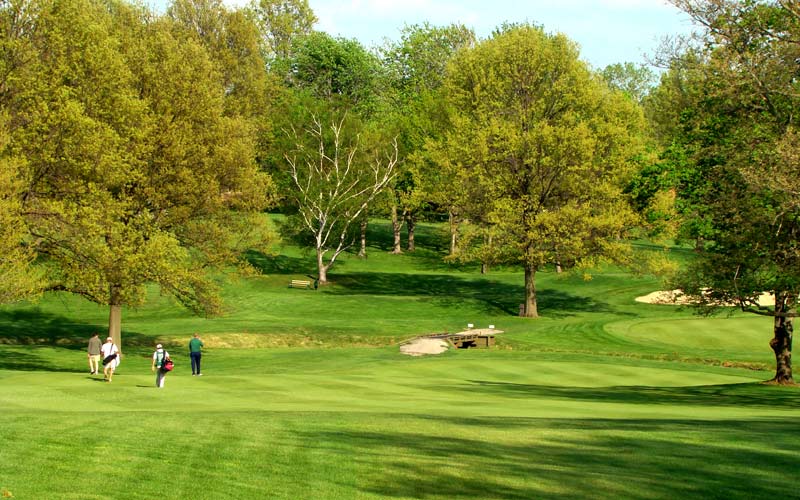
Re-designed in the early 1930s, the tenth now plays as the shortest par four on the course.
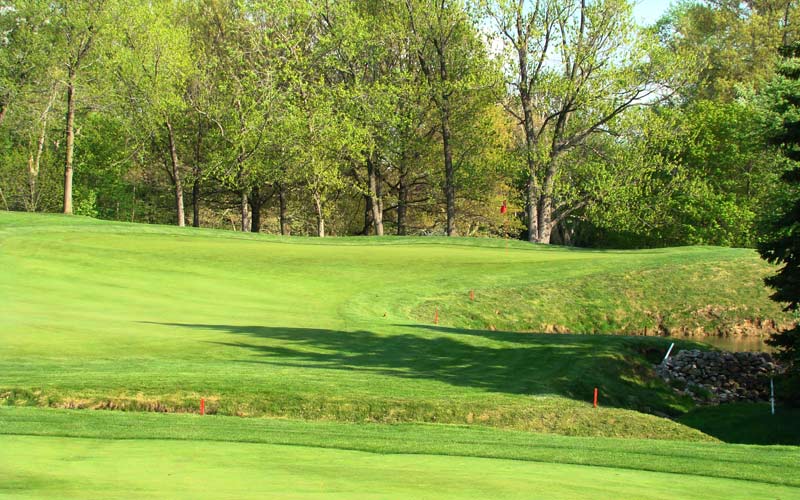
The wedge approach shot needs to avoid the only green-side water hazard on the course. The open
look of the approach has helped make the hole look like it belongs on a Strong design.
Twelfth hole, 370 yards; Another example whereby the drive must carry the crest of a hill. From there, the fairway and green follow the natural slope of the land, which is to stay that the green too slopes from front to back. Hepner admires how fairways such as this one continually make the good golfer make slight adjustments to his stance as the golf ball is invariably one or two inches above or below his feet. Similarly, while riding the course the year before the 1996 U.S. Senior Open, Judy Bell, then president of the USGA, commented to Bonar that she was impressed with the natural undulating fairways and almost lack of a level lie.
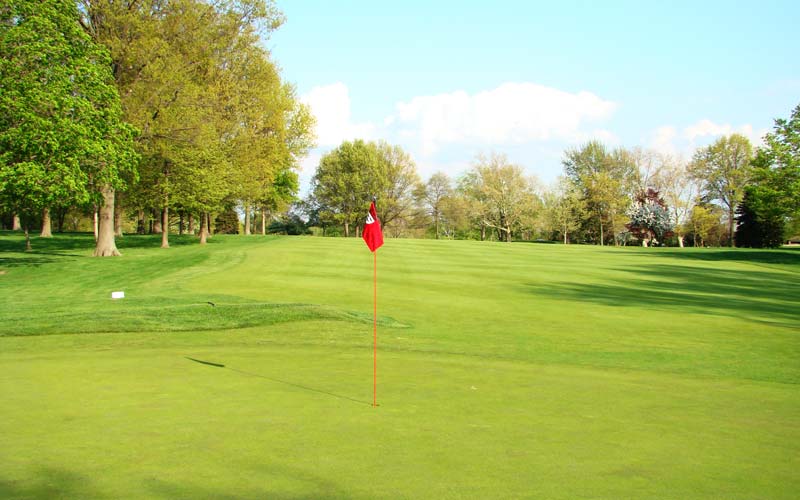
Looking back up twelfth hole, the golfer appreciates that getting close to a forward hole location such as
this one takes some doing as the green does nothing but feed an approach to the back.
Thirteenth hole, 490 yards; The golfer now enters the most rambunctious part of the property and indeed from here in is a roll-a-coaster ride. A good drive leaves the golfer at or just past the crest of the hill with a most engaging long downhill approach shot. The slope of the terrain fifty yards and in feeds approach shots nicely onto the putting surface. As such, the golfer never tires of trying to judge his approach to land just so and release toward the hole. Though Golden Age courses frequently featured such appealing ground game options, it is worth noting that the next four holes all require aerial approach shots, a sign that Strong was intent on fulfilling the request for a rigorous championship test by the Cleveland businessmen that hired him.
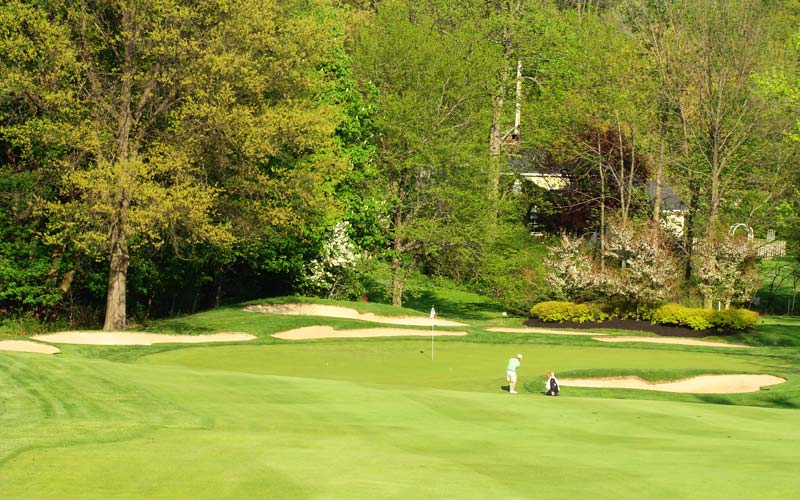
The view down to the thirteenth green, which is ringed by seven bunkers. At, 4,000 square feet, this
green is one of the smallest targets on the course and the long narrow nature of several of
the back bunkers can leave the golfer with awkward recovery shots.
Fourteenth hole, 385 yards; Golfers in the modern era of power golf rarely are forced to shape their tee balls. Not unlike the first, this fairway richly rewards the golfer who can move his tee ball from left to right. Only in that manner will a tee ball stay in the fairway, which is important as the elevated green makes for a difficult target from the rough. According to Bonar, ‘The fourteenth is my favorite hole because no one has ever suggested any changes to it, which is saying something after all the events that we?ve hosted, visits by tour agronomists and the USGA Turf Advisory Service and Master Plans by two architects.’

There wasn’t the need for many fairway bunkers at Canterbury, such was the excellent quality of
the rolling topography. Here at the fourteenth, fairway bunkers would have been superfluous
on this blind drive over the crest of the hill.
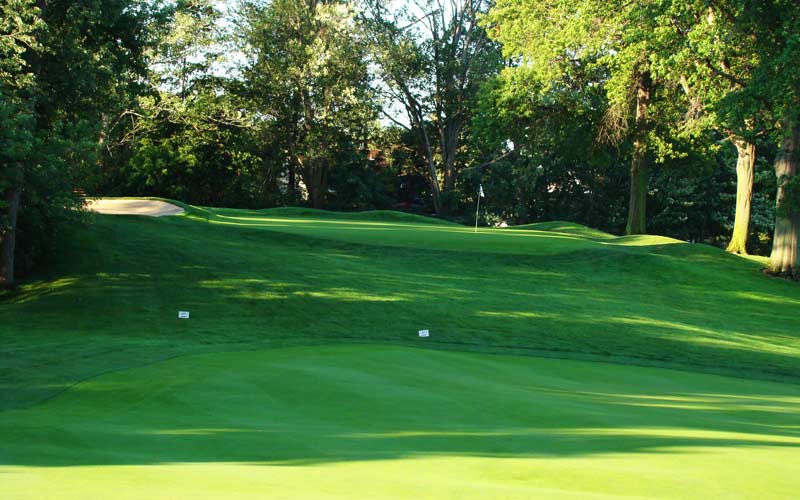
Golfers who don’t shape the ball to the right frequently approach the fourteenth green from the left rough,
which is guaranteed to provide a poor lie and an awkward angle to the plateau green.
Fifteenth hole, 365 yards; This is both Canterbury’s most dramatic and photographed hole. The tee ball feeds downhill to a wide, bunkerless fairway that runs out 260 yards from the tee where a stream crosses. However, it is the forty foot embankment that the golfer must scale with his approach shot that gives the hole its fearsome visual appearance. Especially in the days of hickory golf, this hole was a bear for the typical member. These days, the hole’s primary challenge comes at the green. At thirty five yards, it is the course’s deepest green. A distinct ridge that runs through its middle makes for several mean hole locations and judging one’s approach from so far down below in the fairway is always difficult.
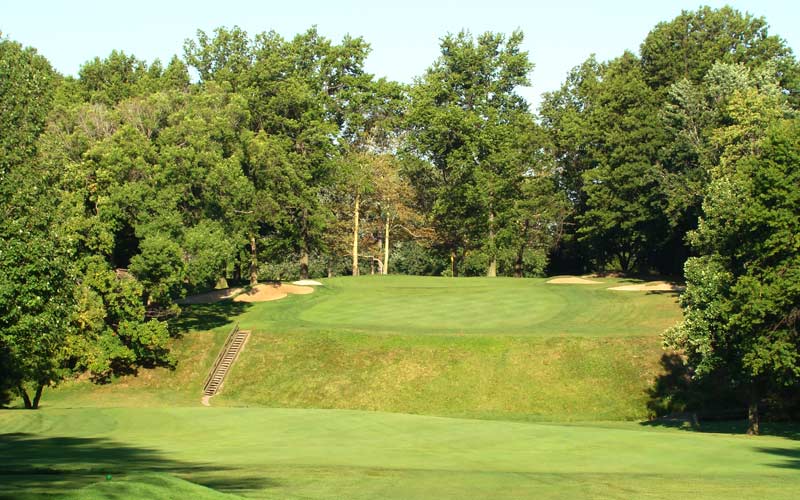
The view from the fifteenth tee perhaps leaves the golfer feeling that he is in New England where such
abrupt landforms are more commonplace. Not surprisingly, Strong was sure to incorporate the
embankment, which is the property’s single most dramatic feature, into his routing.
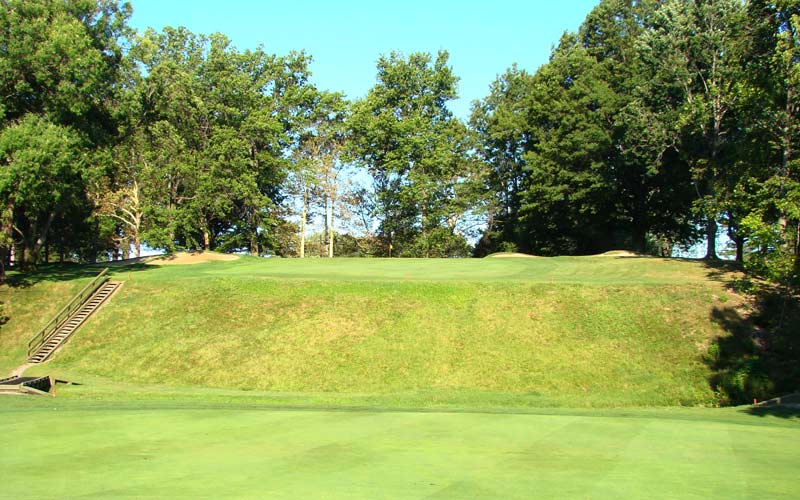
An interesting aspect to the fifteenth involves just how far to drive one’s ball. A 220 yard drive leaves
this approach from approximately 140 yards and the flag (though not the green) is clearly visible.
A drive another thirty yards forward leaves a blind (though shorter) approach.
Sixteenth hole, 610 yards; Famous for over eighty-five years, this original par six (!) is made by Strong’s brilliant routing over the rolling topography. Indeed, no bunkers were required tee to green, so good is the land. In general, a classic par five – par three – par four finish provides the ultimate in variety and the one here at Canterbury is one of the finest such sequences of closing holes anywhere. If played well, the last three holes yield respectively a short iron, a long iron/wood, and a mid iron into three wildly different green complexes. In short, ideal.

The thrilling view from the elevated sixteenth tee encourages the golfer to make a bold positive
swing. The bunkers in the far background ring the back of the green.
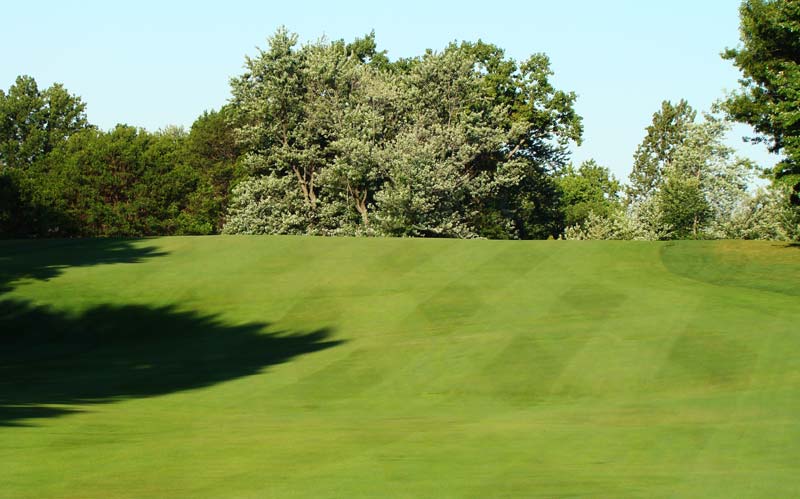
Finding the fairway off the tee is important as otherwise the golfer is unlikely to be able to advance
the ball 200 plus yards to the crest of the hill seen above, which is 130 yards from the green.
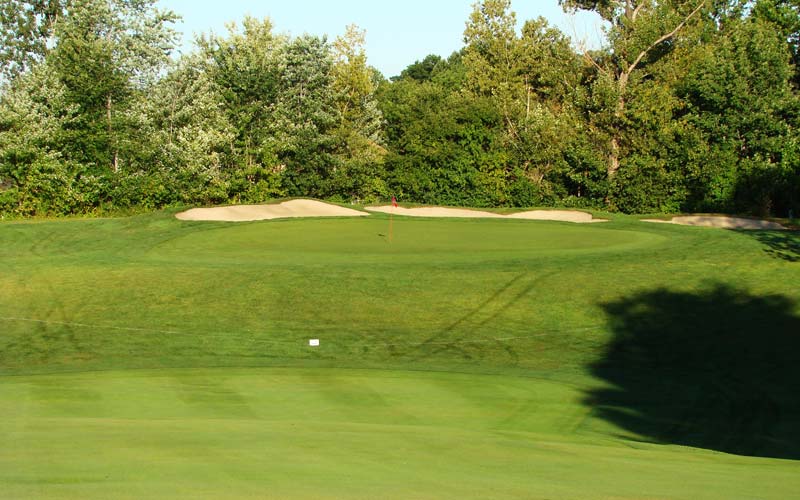
Two good shots leave this manageable pitch to the sixteenth green. Of course, if something
goes wrong on either the first or second shot, the approach shot becomes blind and
much more difficult to gauge.
Seventeenth hole, 230 yards; Modern golf course architects frequently try too hard coming down the stretch. Pete Dye for instance has created more than one par three seventeenth with water that didn’t necessarily fit with the rest of the course. To be fair, television and the demands for an ‘exciting’ finish put pressure on Dye to do so. Fortunately, Strong preceded the need for such artificial contrivances and one of the reasons that Canterbury’s finishing holes are so well regarded is that they never resort to trickery that was out of keeping with the rest of the holes/course. Having said that, the seventeenth is a brute with its long narrow green being a difficult target to find, especially as the penultimate green when the pressure is on.
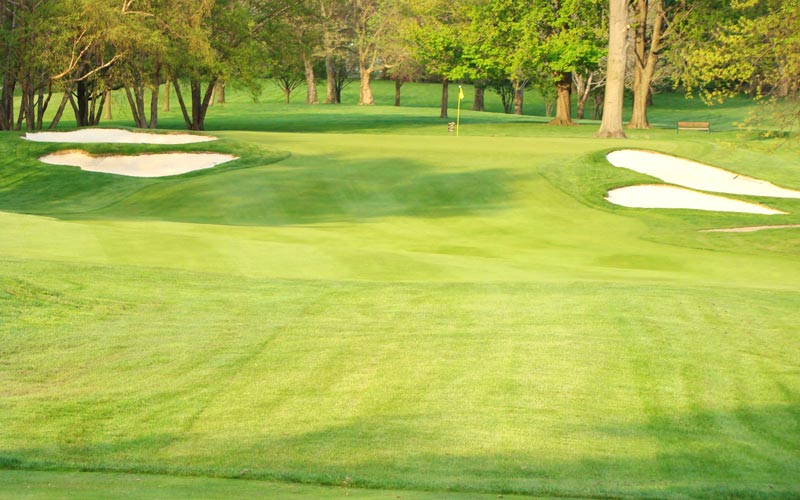
Though full of good golfing qualities, the seventeenth hole sits peacefully upon the land with features
that don’t look contrived or out of place. What better compliment is there for
any architect’s work to receive than that?
Eighteenth hole, 440 yards; Starting at the thirteenth, the golfer goes on quite a walk with all the non-one shotters (i.e. every hole but the seventeenth) going up or down at least thirty feet in elevation. As such, the golfer needs to make sure he doesn’t make a swing with tired legs here at the last as it plays uphill all the way. Canterbury was largely treeless when the course first opened and the approach into this green, which is an extension of the fairway and is open in front, would have enjoyed a links feel to it. The tiny size of some of the bunkers that ring the green’s sides and back are unique to Strong and act as a distinctive reminder that one has just finished a course from one of the masters of the Golden Age in golf course architecture.
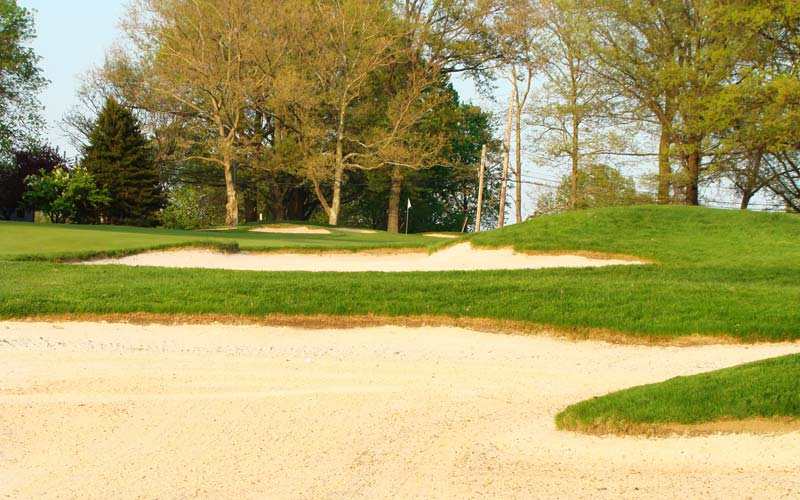
Bigger fairway bunkers down the right by Cornish give way to eight smaller Strong bunkers
that ring the sides and back of the Home green.
Reflecting on one’s round, the golfer can’t help but appreciate several facts. Though he might not see where nearly half of his drives finish due to how the holes fall over the land, Canterbury is a first rate test of shaping one’s tee ball and finding the canted fairways. In addition, the greens taken as a set provide one attractive target after another one. In general, on one’s approach, the golfer is afforded a clear sense of what to try and accomplish. In that manner, he feels like he is in a continual chess match with Strong. Finally, though the greens don’t have the wild interior contours of an Oakland Hills for instance, they remain full of character thanks to their tilt with a premium always on staying below the day’s location.
Ultimately, Canterbury falls in same category as Merion Golf Club in that the golfer struggles to think how this property could have yielded a better design. Though the property wasn’t great per se (i.e. not on sandy soil by a large body of water), the course is. For the golfer that gets out of position (ask Gary Player about his 84 in the final round of the 1973 PGA Championship), the course can bear its teeth. Yet, it never does so based on artificial water hazards or other silly devices employed by architects since Strong’s day. Indeed, the one thing for sure about Canterbury and its apparent simplicity is that it will make you wonder why modern architects with their visual eye candy and the correlating bloated maintenance budgets have senselessly deviated from the standard set here at Canterbury by Strong.

Eighty-five years after Strong delivered one of his best designs, Canterbury still
reigns near the top of classic American parkland courses.




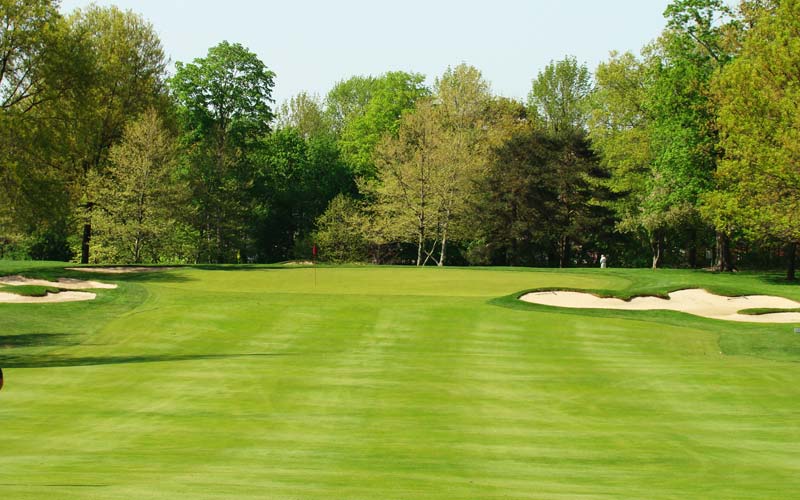

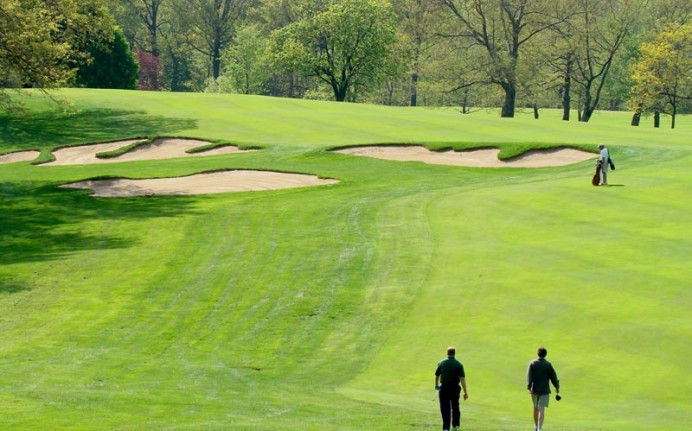
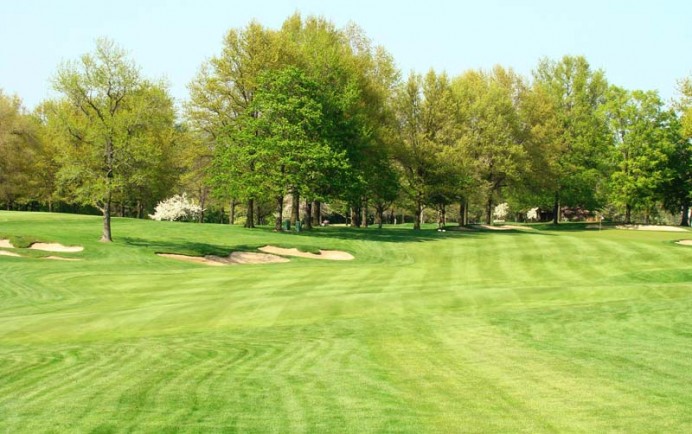
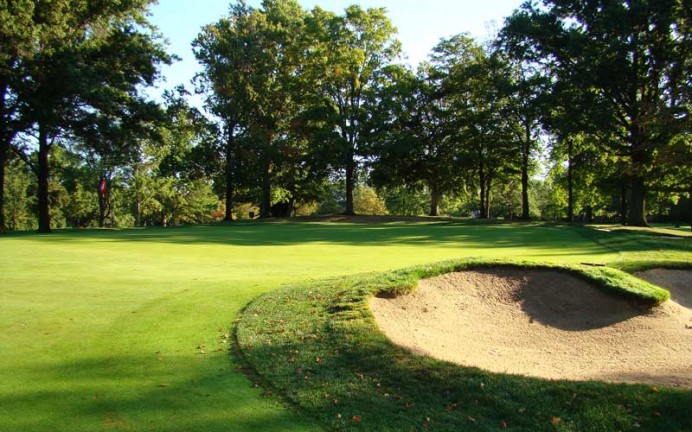


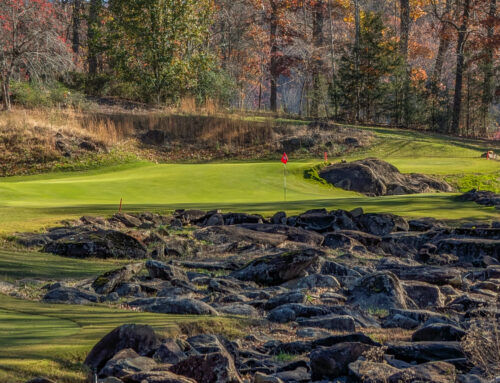
![The Park, West Palm (Lit 9) [2023]](https://golfclubatlas.com/wp-content/uploads/2024/12/IMG_7092-2-scaled-500x383.jpg)
